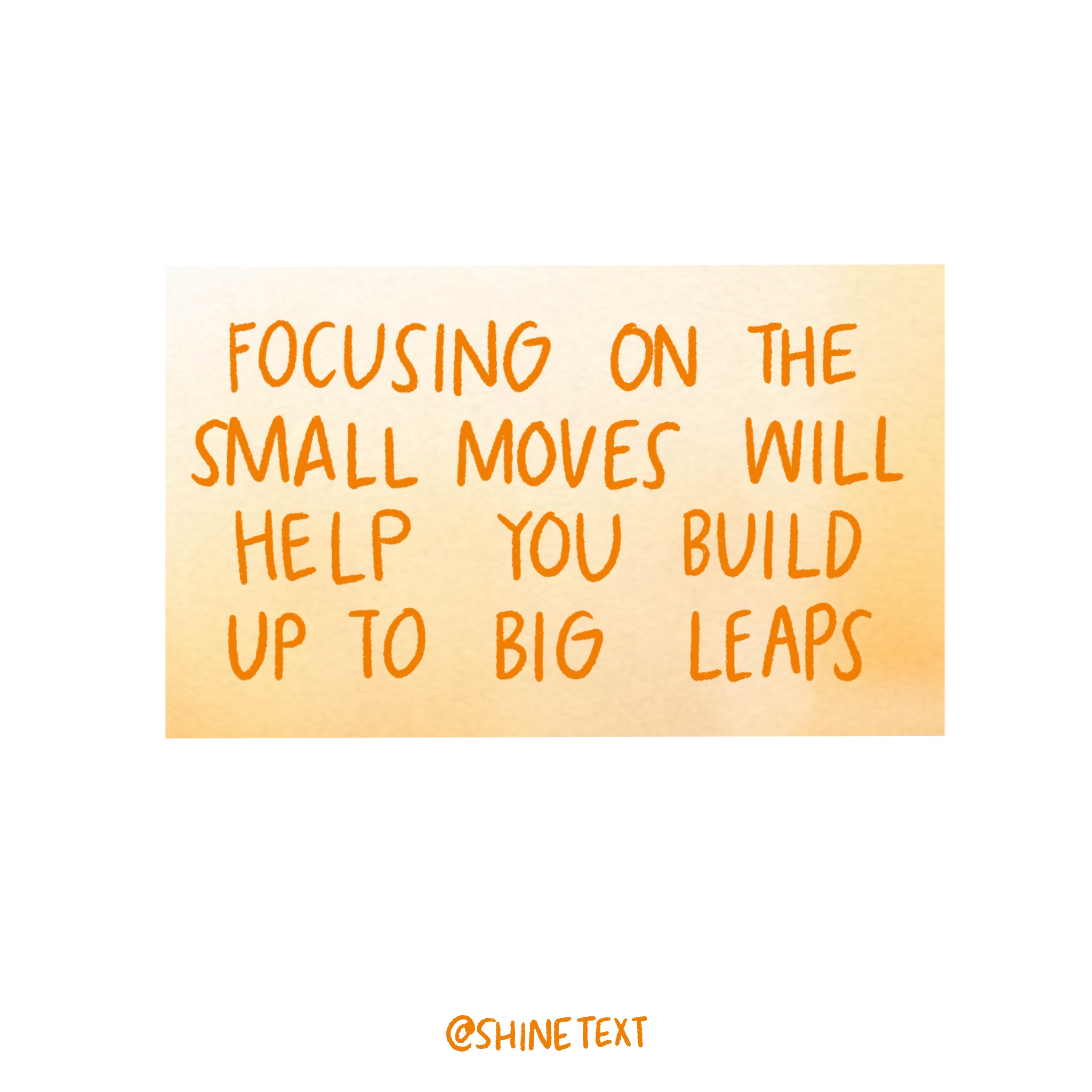Tackling a Big Goal? Focus on Your Small-But-Mighty Moves
Small moves can have major benefits. Don’t believe me? You probably have plenty of them in your own life.
I’m talking about the things that take 10 minutes but leave you with that sunny feeling for the rest of the day.
One of mine is having a super simple breakfast at home. We’re not talking anything fancy here—I throw some oatmeal in the microwave while I’m in the shower—but the small act of starting off the morning on the right foot and with a whopping three minutes of quiet contemplative time makes my entire day better.
For you, maybe it's writing for five minutes before bed or sending a quick "hi, thinking of you!" text to a friend every afternoon.
These moves may not seem earth-shattering, but they have the power to move you a little closer to the habits you want to create and the goals you want to reach. And you can see that progress for yourself.
Here’s how to identify and track your small-to-big wins.
Know What You're Tracking
There are so many possibilities. Perhaps you want to track a fitness goal. I’ve had friends who've had great success with “run streaks” by running a minimum of one mile a day for months at a time and tracking it.
Or it could be work related, from coming up with one new idea a day or reaching out to people in your extended network or applying to one job a day.
Heck, you could even apply this to your dating life, and start a chain of striking up at least one new conversation with a stranger (or a Bumble match…).
Make Sure Your Small Wins Are Doable
Maybe you want to inject a little bit more creativity into your day-to-day.
While “Brainstorm 3 ideas for my next painting/article/Instagram caption” is a good thing to measure to theory, ask yourself: Is this pace really sustainable? The trick is to track something that creates forward momentum and is doable every single day.
Aim for something called "micromastery"—finding a small, concrete skill you can master before leveling up to the next one.
The trick is to track something that creates forward momentum.
Try to pick something specific and easy to accomplish. For instance, if you want to deepen your bond with your network of friends, your tracked habit could be “Text one friend and say ‘hi’ every morning.” This is much more doable that “Plan a coffee meeting every afternoon.”
Create a Chain of Progress
Once you have your doable habit ready, it's time to start creating a chain of progress.
Habit master James Clear is all about a method called “Don’t break the chain”—and speaking from my own experience, it’s incredibly powerful.
Here’s how to do it:
Write a big X on the calendar every day that you have completed your habit. Once you line up quite a few of those Xs, you’re going to want to keep them up.
In other words: Don’t break the chain.
The most productive writing time in my life happened when I committed to writing three pages every day.
I wanted to get better at writing screenplays and plays, and to cure myself of my usual cycle of “write nothing for six months, frantically write 15 pages in one day, exhaust myself, and then write nothing for six more months.”
I started tracking my three pages a day, and seeing those marks on my calendar actually was super inspiring. I kept up the streak for a year and a half. Those days added up: I wrote over 1,642 pages during that long stretch.
The magic is not in waiting for some Big Idea. It’s in tracking your small wins and seeing that you’ve done the work.
The magic is not in waiting for some Big Idea. It’s in tracking your small wins and seeing that you’ve done the work.
Show Off Your Small Wins
This productivity hack is easier to adopt if you add it to a system you already use regularly.
For instance, when I started my “write three pages a day” streak, I kept track in my Google Calendar, and simply wrote “THREE PAGES” and tagged it purple, so I could clearly see my streak. Another digital way to track your new habit through something like Done, a simple habit tracker app that has one job: Creating “chains” for any action that you want.
If you’re someone who prefers an analog tracker, you can buy a desk calendar—seeing those big X’s sitting under your laptop will make them hard to ignore.
Another tactic is to place your calendar of Xs in a place you see often—perhaps on your bathroom mirror, your refrigerator door, or the cabinet where you grab your coffee mug every morning.
Seeing the chain should provoke a reminder of what you’ve said you value and want to improve, and hopefully, spark some inspiration to keep it up. Just imagine what an entire month of Xs would look like!
Seeing the chain should provoke a reminder of what you’ve said you value and want to improve, and hopefully, spark some inspiration to keep it up.
Celebrate Your Wins—and Have Compassion If You Break the Chain
Kept up your chain for a week? Yay! A month? AWESOME! A year?! Throw yourself a party. Because that’s the beauty of keeping track—you know where your effort has gone and can see what has come from it.
Broke your chain after a few days? After you had a weeks-long streak going? Even though the strategy is called "Don't break the chain," it's important to remember: Life happens. The chain might break here and there. The Xs are meant to be a tool to motivate you to keep at it—not shame yourself if there's an empty box.
If your neat little row of Xs gets derailed, be kind to yourself. Take pride in how many days you did keep up the chain, and remember that progress isn't lost. You're still on your way, and tomorrow is another chance to log an X on that habit.
So find your little to-dos with outsized benefits, start your chain, keep it up, reap the rewards, and if you reach your goal, nothing’s stopping you from creating a new chain. Let the X’s begin.
Read next: Why Your Small Wins Matter More Than a Big #GlowUp Moment

Shine is supported by members like you. When you buy through links on our site, we may earn an affiliate commission. See our affiliate disclosure for more info.


